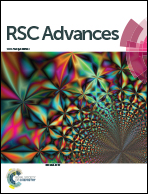UV-assisted reduction of in situ electrospun antibacterial chitosan-based nanofibres for removal of bacteria from water
Abstract
A greener synthesis of low-swelling uniformly-sized chitosan (CTS)-based nanofibres decorated with silver (Ag) and silver/iron (Ag/Fe) nanoparticles is reported. The synthesis was achieved by electrospinning a solution of CTS blended with varying amounts of polyacrylamide (PAA), polyethylene glycol (PEG) and Ag+ or Ag+/Fe3+ ions. These nanofibres were subjected to UV irradiation under ionised water vapour at low temperature (70 °C). The effect of UV irradiation time on the reduction of the NPs was confirmed using UV-Vis spectroscopy. The microstructure and chemical composition of the Ag and Ag/Fe modified nanofibres was studied using transmission electron microscopy (TEM), energy dispersive X-ray spectroscopy (EDS), X-ray diffraction (XRD) and ultraviolet-visible spectroscopy (UV-Vis). TEM revealed that the average diameter of the CTS-based nanofibres, AgNPs, and Ag/Fe NPs supported on the CTS-based nanofibres were 471 ± 89 nm, 18 ± 2.5 and 32 ± 8.7 nm respectively. XRD and EDS analysis confirmed the presence of Ag and Fe in the nanofibers. The biocidal effect of the Ag and Ag/Fe NPs supported on the CTS-based nanofibres was investigated using Gram positive (Bacillus cereus, Enterococcus faecalis) and Gram negative (Escherichia coli, Klebsiella pneumoniae, Klebsiella oxytoca, Pseudomonas aeruginosa, Proteus mirabilis, Shigella boydii, Shigella sonnei, Enterobacter cloacae) bacterial strains. The nanofibres exhibited a strong biocidal effect on the bacteria suggesting that they can be used as efficient antimicrobial materials in water systems that are contaminated by bacteria.



 Please wait while we load your content...
Please wait while we load your content...